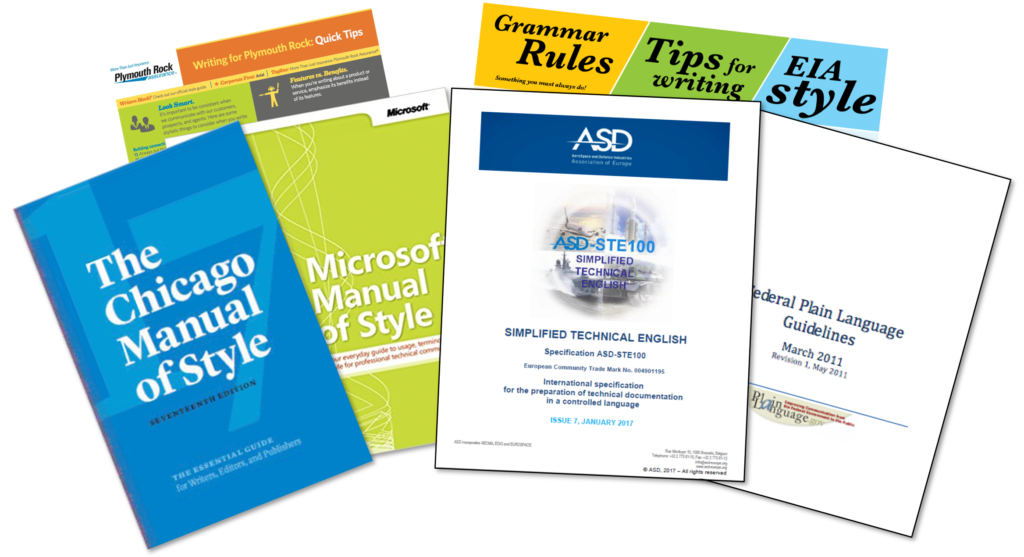Style guides can help us achieve clarity in writing. Also, they align our (global) team of technical writers, and improve our branding. But which style guide or writing standard to use? There are a number of style guides or writing standards around. Depending on your specific needs, they all can help you achieve your content goals. In this article, we’ll be comparing some important style guides.
Style guides
STE vs. ASD-STE100
Simplified Technical English is a controlled language that promotes clarity in writing. When we refer to Simplified Technical English (STE), we are not necessarily talking about the ASD specification called ASD-STE100, which is mandated for technical publications in the aerospace and defense industries. We are referring to STE as a generic term used to achieve clarity in writing as it can be customized to meet your specific style guide needs.
Customize STE to meet your specific needs
The best way the STE spec is used here is by putting a company or industry dictionary on top of the STE dictionary (which contains about 3000 words). Where you do need to then still standardize those terms. This means you have to make a selection of which words are approved, and which words (with the same meaning) are not approved. Using the STE spec this way, including the ability to customize the rules, allows you to create your own version of STE. Everything while still being able to come to informed decisions about whether to approve or not approve terms. You can always compare them against a proven writing standard.
Microsoft Manual of Style
The Microsoft Manual of Style (MMoS) is a style guide published by Microsoft guides. It’s made by technical writers, editors, and content managers working with Microsoft products. The style guide also serves as a general tool for technical writers. It also provides specific information and instructions for naming particular elements of specific applications to general grammar rules. The Microsoft Manual of Style is not based on controlled language. Hence less strict about the use of grammar and terminology. However, there is an overlap with STE. Being less strict than STE means that the writer will have more choices on how to write. Nevertheless, more choices could lead to an inconsistent style. The Microsoft Manual of Style contains a usage dictionary of terms commonly used in technical writing.
 Chicago Manual of Style
Chicago Manual of Style
The Chicago Manual of Style (CMoS) is a style guide for American English. Published by the University of Chicago Press and prescribes writing and citation styles widely used in publishing. The style guide does not specifically focus on technical writers or technical documentation. Hence, the Chicago Manual of Style is quite elaborate. As a result, the Chicago Manual of Style provides different information on how to use the American English language instead of providing clear, unambiguous writing instructions. The Chicago Manual of Style is not based on controlled language and does not contain a specific usage dictionary.
Plain Language as a style guide
Compared to STE, MMoS and CMoS, Plain Language is not a style guide with specific writing rules or approved terminology. The purpose of Plain Language is to make the text easy to read, understand, and use. In 2019 ISO formed a working group to develop plain language standards and guidelines.
IEC/IEEE 82079-1, ISO 20607
These are not so much writing standards. But international standards that manufacturers of machinery may need to comply with. Both standards, however, include references to best practice writing rules for technical documentation. These have a lot of similarities to STE. In other words, complying with STE automatically means you comply with these standards as well.
Combining style guides
Since these writing standards and style guides serve different purposes and are not the same as how they are set up, it does not mean they must be used independently. Writing standards and style guides can be used in combination with each other. This to achieve your goals for clarity in writing. In other words, they can be compatible.
- For more information on the values clarity in writing brings, and how to create a content strategy with KPIs and metrics, please visit this page.
- For more information on what’s involved with an implementation, please visit this page.
- We offer free business case analyses if you want to know what STE can do for you. Contact us today for more information!
This article was written by Roy Wijnen, Product Manager Controlled language at Etteplan.

